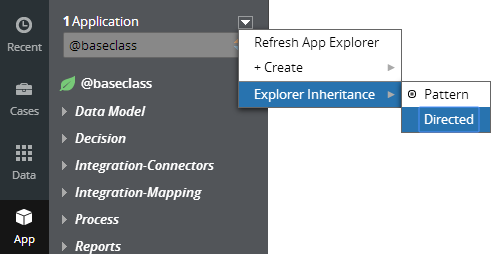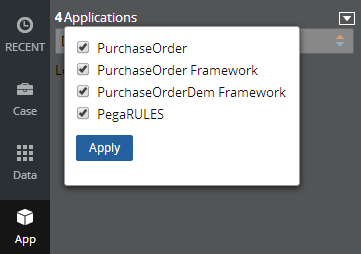Guardrails compliance score
Valid from Pega Version 7.1.5
The Application Guardrails landing page has been enhanced to help you build more guardrail-compliant applications. Increase transparency and accountability on your projects by responding to the following compliance score metrics:
- A weighted compliance score (0-100) based on warnings, severity, and justification
- A percentage of compliant rules in your application
- Total number of rules in your application
- Total number of rules in your application with warnings (justified and unjustified)
Additional metrics include alert and interaction count trends over the last four weeks.
For more information, see Guardrails compliance score.
Directed inheritance view in Application Explorer
Valid from Pega Version 7.1.5
You can now specify which inheritance model is used to populate classes in the Application Explorer. From the top level menu, use the “Explorer Inheritance” option to choose between:
- Pattern: only display class names whose prefix matches the root node class name.
- Directed: first display classes that explicitly name the root node as the parent class; then display classes with pattern inheritance.

By default, the Application Explorer loads using Pattern inheritance.
Save Application Explorer filter selections
Valid from Pega Version 7.1.5
Application scoping control selections made in the Application Explorer are now persisted between sessions. These preferences are stored in an operator record on an access group level. If you delete (and later re-add) an access group on your operator form, the application scoping control defaults to all layers selected:

External access control DASS
Valid from Pega Version 7.1.5
A new Dynamic Admin System Setting (DASS) controls the Designer Studio's access to external systems, specifically the PDN RSS feed found on the home page.
By default, Pega-Desktop.AllowAccessToExternalSystem is set to TRUE. Update this setting to FALSE to hide the PDN RSS feed and ensure that no RSS fetch is performed.
Real-time event processing
Valid from Pega Version 7.1.9
Real-time event processing is a mechanism that can be used to analyze a high velocity stream of events entering the system and derive conclusions from them. It is possible to define metrics, measurements, and conditions under which subsequent trigger events are generated.
For details, see Real-time event processing.
End of support for form-based rule forms in Pega 7.1.9
Valid from Pega Version 7.1.9
Rule forms that are configured to render as forms are no longer supported in Designer Studio or end-user applications. Form-based configurations are found on custom rule types that were created in earlier versions of Pega 7 and are characterized by pop-up windows that are rendered externally from Designer Studio.
Reconfigure Pega 7 applications that use such rule forms by using standard harnesses and sections.
- Open the class form.
- Click the Advanced tab.
- Select
Harnessfrom the menu. - Create a new harness and new sections that implement the logic of the custom rule, using standard user interface layouts and controls.
Migrating custom rule forms to harnesses and sections offers the following benefits:
- User interfaces become HTML5 WC3 compatible and responsive to different screen sizes.
- User interfaces become cross-browser compatible, rendered consistently in Google Chrome, Mozilla Firefox, Apple Safari, and recent versions of Microsoft Internet Explorer.
- Rendering performance on modern browsers is dramatically improved.
- User interface pop-up behavior is eliminated; all windows are rendered inside Designer Studio and end-user applications.
Text analytics on the Pega 7 Platform
Valid from Pega Version 7.1.9
The Pega 7 Platform offers users the capability to analyze units of text, extract quality information, and translate it into business intelligence. The text analytics functionality aims to determine the positive, negative, and neutral polarities (tone) of subjective sentences. It also provides mechanisms for categorizing units of text and classifying text elements into predefined categories. You can use it to analyze text-based content including news feeds, emails, and postings on social media streams, such as Facebook, Twitter, and YouTube.
For more information, see Introduction to text analytics on the Pega 7 Platform.
Updates to the Data Flow rule
Valid from Pega Version 7.1.9
It is now possible to use report definitions as primary and secondary sources in the Data Flow rule. The data flows that are sourced by a report definition can be distributed on multiple nodes. When using a database table data set as the destination of the data flow, you need to select one of the save options for the data set (insert records or insert and update records).
Updates to the Event Strategy rule
Valid from Pega Version 7.1.9
When you design event strategies, you can use the Filter shape for basic arithmetic and text expressions. You can also specify start conditions for the tumbling and sliding windows.
Updates to the Predictive Model rule form
Valid from Pega Version 7.1.9
The Predictive Model rule form provides the XML schema preview for uploaded PMML models. You can use this preview to view the structure of a model and to correct errors before saving the rule. When the model contains errors, they are displayed in the Errors section at the bottom of the rule.

